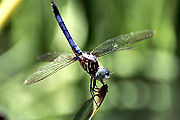
Obelisk posture
Encyclopedia

Handstand
A handstand is the act of supporting the body in a stable, inverted vertical position by balancing on the hands. In a basic handstand the body is held straight with arms and legs fully extended, with hands spaced approximately shoulder-width apart...
-like position that some dragonflies and damselflies assume to prevent overheating on sunny days. The abdomen
Abdomen
In vertebrates such as mammals the abdomen constitutes the part of the body between the thorax and pelvis. The region enclosed by the abdomen is termed the abdominal cavity...
is raised until its tip points at the sun, minimizing the surface area exposed to solar radiation. When the sun is close to directly overhead, the vertical alignment of the insect
Insect
Insects are a class of living creatures within the arthropods that have a chitinous exoskeleton, a three-part body , three pairs of jointed legs, compound eyes, and two antennae...
's body suggests an obelisk
Obelisk
An obelisk is a tall, four-sided, narrow tapering monument which ends in a pyramid-like shape at the top, and is said to resemble a petrified ray of the sun-disk. A pair of obelisks usually stood in front of a pylon...
.
Function and occurrence

Blue Dasher
The Blue Dasher is a dragonfly of the skimmer family. It is common and widely distributed in the United States....
s (Pachydiplax longipennis) assume an obelisk-like posture while guarding their territories or during conflicts with other males, displaying the blue pruinescence
Pruinescence
Pruinescence, or pruinosity, is a "bloom" caused by pigment on top of an insect's cuticle that covers up the underlying coloration, giving a dusty or frosted appearance. The pruinescence is commonly white to pale blue in color, but can also be gray, pink, purple, or red; these colors may be...
on their abdomens to best advantage. However, both females and males will raise their abdomens at high temperature and lower them again if shaded. This behavior can be demonstrated in the laboratory by heating captive Blue Dashers with a 250 watt lamp, and has been shown to be effective in stopping or slowing the rise in their body temperature.
The obelisk posture has been observed in about 30 species in the Demoiselle
Calopterygidae
Calopterygidae are a family of damselflies in the order Odonata and are commonly known as broad-winged damselflies or demoiselles. These rather large damselflies have wingspans of 5–8 cm and they're often metallic-coloured. The family contains some 150 species...
, Clubtail
Gomphidae
Gomphidae is an Odonata family that contains about 90 genera and 900 species. They are commonly referred to as clubtail dragonflies. The name refers to the clublike widening of the end of the abdomen...
, and Skimmer
Libellulidae
The skimmers or perchers and their relatives form the Libellulidae, the largest dragonfly family in the world. It is sometimes considered to contain the Corduliidae as the subfamily Corduliinae and the Macromiidae as the subfamily Macromiinae. Even if these are excluded , there still remains a...
families. All are "perchers" -- sit-and-wait predators that fly up from a perch to take prey and perch again to eat it. Since they spend most of their time stationary, perchers have the most opportunity to thermoregulate by adjusting their position.
Other forms of postural thermoregulation

Dragonhunter
The Dragonhunter or Black Clubtail , sometimes called the Black Dragon, is a clubtail dragonfly of the eastern United States and southeastern Canada....
(Hagenius brevistylus), reduce exposure to the sun by perching with the abdomen pointed downward, rather than upward. The tropical skimmer
Libellulidae
The skimmers or perchers and their relatives form the Libellulidae, the largest dragonfly family in the world. It is sometimes considered to contain the Corduliidae as the subfamily Corduliinae and the Macromiidae as the subfamily Macromiinae. Even if these are excluded , there still remains a...
dragonfly Diastatops intensa, whose wings are mostly black, points its wings rather than its abdomen at the sun, apparently to reduce the heat they absorb.
While flying, some Saddlebags Gliders (genus Tramea
Tramea
Tramea is a dragonfly genus in the family of skimmer and percher dragonflies . They typically have colored bases to their otherwise translucent hindwings...
) lower their abdomens into the shade provided by dark patches at the bases of their hindwings. The same behavior has been observed in Pseudothemis zonata, which has a similar hindwing patch.
Dragonflies also use postural thermoregulation to increase body temperature. Keeping the flight muscles in the thorax
Thorax
The thorax is a division of an animal's body that lies between the head and the abdomen.-In tetrapods:...
warm is especially important, since otherwise the insect cannot fly. Dragonflies may position their wings to reflect sun onto themselves, or, if they are perched on a warm surface, to form a "greenhouse" over the thorax. When the sun is low in the sky, they may raise or lower their abdomens so that their bodies are perpendicular to the sun's rays, maximizing the surface area that receives direct sun; although this can resemble the obelisk posture, the purpose is opposite.

